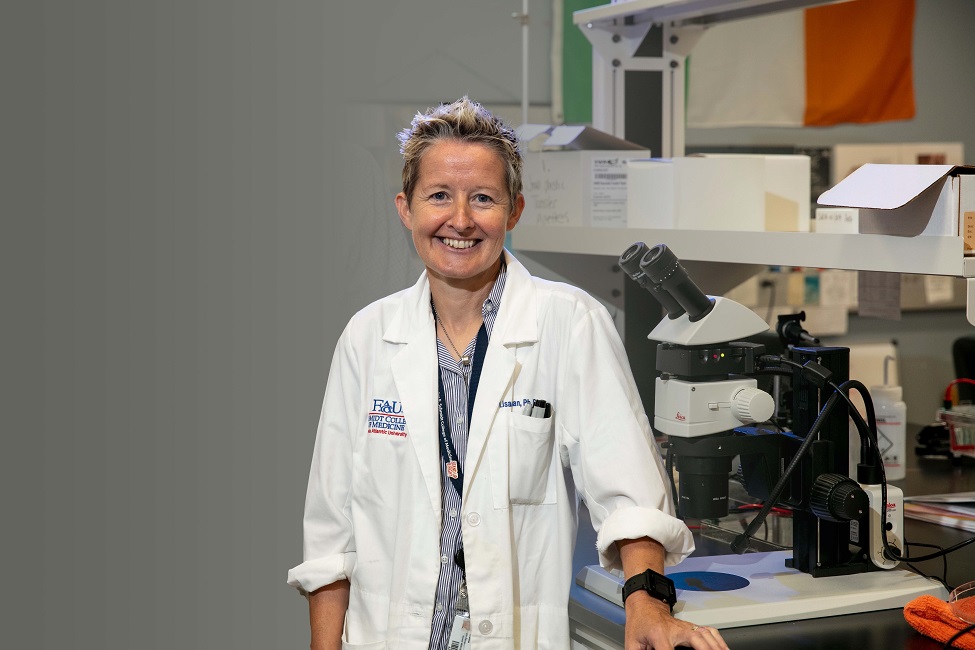FAU Emerging Scientist to Receive 2022 "Cataract Research Award"

Lisa Ann Brennan, Ph.D., an associate research professor in the Schmidt College of Medicine. (Photo by Alex Dolce)
Florida Atlantic University’s Lisa Ann Brennan, Ph.D., an associate research professor in the Schmidt College of Medicine, will receive the prestigious 2022 National Foundation for Eye Research’s (NFER) “Cataract Research Award.” The award is given annually by the NFER to honor “an emerging scientist who has made significant contributions to lens and cataract research, and who shows promise of developing into an international leader in the field.” Brennan will receive the award in May at the Lens Business Meeting of the Association for Research in Vision and Ophthalmology (ARVO) meeting in Denver.
“We are incredibly proud of Dr. Brennan for receiving this well-deserved recognition for her invaluable contributions in the field of cataract research,” said Julie Pilitsis, M.D., Ph.D., M.B.A., dean and vice president of medical affairs, FAU Schmidt College of Medicine. “For more than 15 years, she has worked in concert with Dr. Marc Kantorow in the medical school to advance research aimed at addressing non-surgical treatments for cataracts and to identify the molecular and genetic mechanisms involved in eye development and disease.”
According to the World Health Organization (WHO), cataract is responsible for 51 percent of world blindness and remains the leading cause of blindness. Most cataracts develop when aging or injury changes the tissue that makes up the eye's lens. Proteins and fibers in the lens begin to break down, causing vision to become hazy or cloudy. According to the American Academy of Ophthalmology, cataracts affect more than 24.4 million Americans age 40 and older. By age 75, about half of all Americans have cataracts. Currently, surgery is the only way to treat cataracts.
“Dr. Brennan is recognized within the lens community as a top-drawer experimentalist, who has served that community with energy, dedication and innovation. Her research will deliver new therapeutic strategies to prevent and treat cataract and therefore make a real difference to patients,” said Roy Quinlan, Ph.D., emeritus professor of biomedical sciences, Durham University, United Kingdom. “The National Foundation for Eye Research is dedicated to the support and promotion of lens and cataract research. I am very pleased to support Dr. Brennan who is most worthy of receiving the ‘Cataract Research Award.’”
Brennan is recognized for her contributions to cell biology and the cellular oxidative stress responses involving mitochondria, the nucleus and autophagy pathways. A long-sought question in the field has been what regulates the elimination of organelles – specialized structures that perform various jobs inside cells – to form the transparent lens organelle-free zone. Her work has pioneered the understanding of the mechanisms and pathways leading to lens organelle degradation through the discovery that the elimination of non-nuclear organelles in the lens was dependent on mitophagy and required the hypoxic environment of the lens itself. The work also is the first to show that hypoxia (insufficient oxygen) plays a fundamental role in tissue development and differentiation. It identifies the hypoxic environment of the lens as essential for its transparent structure and implicates loss of hypoxia as a potential contributor to cataract formation. Recently, Brennan’s work also has made important contributions toward understanding the degradation of lens nuclei, leading to the discovery of novel structures involved in lens nuclear degradation.
“Dr. Brennan’s work has significantly advanced our knowledge of the lens and the mechanistic detail of cataract formation,” said Kantorow, associate dean for graduate programs and a professor of biomedical science, FAU Schmidt College of Medicine. “There are very few young investigators who have made such a diverse and important set of contributions to our field. She continues to push the boundaries of lens research and I predict she will continue to make outstanding contributions and seminal discoveries in lens research.”
Brennan’s work also confirmed that HIF1 – a protein complex that plays an integral role in the body’s response to hypoxia – regulates both the activation and suppression of a wide variety of genes essential for lens differentiation. She has made major contributions to the discovery that chromatin remodeling is an essential requirement for lens development, differentiation and structure. In addition, oxidative stress and UV-light play important roles in cataract formation and Brennan’s research has greatly contributed to the knowledge of the mechanisms the lens employs to combat these insults and maintain transparency.
-FAU-
Tags: faculty and staff | science | research | medicine